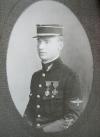The creation of Czechoslovakia
During the 19th century, the population, especially in the mountain areas, grew faster than industrial and economic modernisation. Poverty and hope for a better life brought approximately 100,000 Slovaks to Budapest; another 500,000 emigrated to the United States before 1914, where they found jobs in mines and factories. In the free environment they became emancipated surprisingly fast as citizens, as humans and as a nation. Ruthenians in the north-eastern part of Slovakia and sub-Carpathian Ukraine shared a similar fate. It was the beginning of a mass emigration from Slovakia, which assumed various rates of intensity and was the result of various causes, yet continues even up to this day.
 The First World War also radically affected life in Slovakia. While patriotic propaganda reigned in Austro-Hungary, groups of Czech and Slovak politicians began organise an anti-Austrian resistance in the west of Europe, the USA and Russia. In 1915 in the United States, Czech and Slovak representatives signed the Cleveland Agreement on the creation of an independent Czechoslovakia on a federative basis which guaranteed Slovakia autonomy. The Czechoslovak National Council in Paris, headed by T G Masaryk, E Beneš and M R Štefánik, became the leader of the resistance movement.
The First World War also radically affected life in Slovakia. While patriotic propaganda reigned in Austro-Hungary, groups of Czech and Slovak politicians began organise an anti-Austrian resistance in the west of Europe, the USA and Russia. In 1915 in the United States, Czech and Slovak representatives signed the Cleveland Agreement on the creation of an independent Czechoslovakia on a federative basis which guaranteed Slovakia autonomy. The Czechoslovak National Council in Paris, headed by T G Masaryk, E Beneš and M R Štefánik, became the leader of the resistance movement.
Thanks to well thought-out diplomacy, the support of patriots from the USA and its own army – legions fighting in Russia, Italy and France – they convinced the politicians of the Allied Powers of the usefulness of the creation of Czechoslovakia. The fact that Polish and Yugoslavian politicians took a similar course of action helped. Czecho-Slovakia was spontaneously proclaimed in Prague on 28 October 1918. Slovaks acknowledged it two days later through the Declaration of the Slovak Nation, adopted in Martin by the Slovak National Council.
As a result of the decline of Hungary and the establishment of the Czecho-Slovak Republic, the Slovaks found themselves in a completely new situation. The borders of Slovakia and its capital Bratislava were officially determined for the first time and Slovak became the official language in schools and offices. Slovak culture, art and education flourished within the framework of Europe. The first Slovak University - Comenius University - the Slovak National Theatre and several cultural, artistic and scientific associations, with Matica slovenská at the forefront, were established. The cultural life of the Hungarian, German and Jewish minorities also developed positively in the democratic climate. They had their own political parties and representations.
However the economy in Slovakia went through a much more traumatic period. Although Slovakia together with Budapest constituted a more industrial area in comparison with the Czech lands, its industry was not very competitive. Many factories closed down and new factories were slow to replace them. This led to an increase in social and national tensions. Industrial production in Slovakia did not reach its 1913 level until 1937. However it was substantially more modern.
In the 1930s Czechoslovakia was the only Central European state to retain its democratic character. It became an asylum for persecuted democrats, communists and Jews from the surrounding countries. However its weakness was the unified character of the state, the constitutionally-anchored idea of the Czechoslovak nation (Czechoslovakism) and the growing ambitions of minorities. In Slovakia, the strongest political party – Hlinka’s Slovak People’s Party – and the smaller Slovak National Party expressed their disagreement with the status quo. For two decades they had clamoured for the acknowledgement of Slovaks as an independent nation and the legalisation of the autonomous status of Slovakia. The majority of political parties of Germans and Magyars were not satisfied with their status and national rights established by the Czechoslovak laws, which, by the way, were quite tolerant. These factors strengthened the social discrepancies and tensions and weakened Czechoslovakia; but its breakdown was caused by the pressure of revisionism from the outside.
